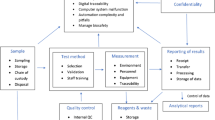Abstract
Introduction
The first section of the document describes a risk-prevention strategy, called SOBANE, in four levels: screening, observation, analysis and expertise. The aim is to make risk prevention faster, more cost effective, and more effective in coordinating the contributions of the workers themselves, their management, the internal and external occupational health (OH) practitioners and the experts. These four levels are: screening, where the risk factors are detected by the workers and their management, and obvious solutions are implemented; observation, where the remaining problems are studied in more detail, one by one, and the reasons and the solutions are discussed in detail; analysis, where, when necessary, an OH practitioner is called upon to carry out appropriate measurements to develop specific solutions; expertise, where, in very sophisticated and rare cases, the assistance of an expert is called upon to solve a particular problem.
Method
The method for the participatory screening of the risks (in French: Dépistage Participatif des Risques), Déparis, is proposed for the first level screening of the SOBANE strategy. The work situation is systematically reviewed and all the aspects conditioning the easiness, the effectiveness and the satisfaction at work are discussed, in search of practical prevention measures. The points to be studied more in detail at level 2, observation, are identified. The method is carried out during a meeting of key workers and technical staff.
Conclusion
The method proves to be simple, sparing in time and means and playing a significant role in the development of a dynamic plan of risk management and of a culture of dialogue in the company.
Similar content being viewed by others
References
Anon (2002) Control banding workshop. A joint workshop held in November 2002 with BIOH and IOHA supported by HSE, WHO and ILO, http://www.bohs.org/mod.php?mod=fileman&op=view_cat&id=14
BS 8800 (1996) Guide to occupational health and safety management systems. BSI
European Communities (1989) Council Directive 89/391/EEC of 12 June 1989 on the introduction of measures to encourage improvements in the safety and health of workers at work, Official Journal L 183, 29/06/1989 pp 0001–0008
Goelzer BIF (1996) Yant Award Lecture: “The harmonized development of occupational hygiene—a need in developing countries”, presented on 21 May 1996, at the American Industrial Hygiene Conference and Exposition, Washington, DC, USA
International Labour Office (2001) Guidelines on occupational safety and health management systems, ILO-OSH 2001, Geneva, p 40
International Standard ISO 7933 (1991) Hot environments—analytical determination and interpretation of thermal stress using calculation of required sweat rates. International Standard Organisation, Geneva, Switzerland
Malchaire J (2000). Strategy for prevention and control of the risk due to noise. Occup Environ Med 57:361–369
Malchaire J, Piette A (1997) A comprehensive strategy for the assessment of noise exposure and risk of hearing impairment. Ann Occup Hyg 41:467–484
Malchaire J, Piette A (2001) Stratégie de prévention des risques dus à l’utilisation de machines vibrantes. Recueil des résumés du 9ème congrès international sur les vibrations mains-bras, 5–8 June 2001, Nancy, France
Malchaire J, Piette A (2002) Co-ordinated strategy of prevention and control of the biomechanical factors associated with the risk of musculoskeletal disorders. Int Arch Occup Environ Health 75:459–467
Malchaire J, Piette A, Cock N (1998a) Stratégie d’évaluation et de prévention des risques liés au bruit. Commissariat général à la Promotion du Travail, Ministère de l’Emploi et du Travail
Malchaire J, Piette A, Cock N (1998b) Stratégie d’évaluation et de prévention des risques liés aux ambiances thermiques. Commissariat général à la Promotion du Travail, Ministère de l’Emploi et du Travail
Malchaire J, Piette A, Cock N (1998c) Stratégie d’évaluation et de prévention des risques liés à l’éclairage. Commissariat général à la Promotion du Travail, Ministère de l’Emploi et du Travail
Malchaire J, Piette A, Cock N (1998d) Stratégie d’évaluation et de prévention des risques liés aux vibrations corps total. Commissariat général à la Promotion du Travail, Ministère de l’Emploi et du Travail
Malchaire J, Piette A, Cock N (1998e) Stratégie d’évaluation et de prévention des risques liés aux vibrations mains-bras. Commissariat général à la Promotion du Travail, Ministère de l’Emploi et du Travail
Malchaire J, Gebhardt HJ, Piette A (1999) Strategy for evaluation and prevention of risk due to work in thermal environments. Ann Occup Hyg 43:367–376
Malchaire J, Piette A, Cock N (2002) Stratégie d’évaluation et de prévention des risques liés aux troubles musculosquelettiques du dos et des membres supérieurs. Ministère fédéral de l’Emploi et du Travail
Occhipinti E, (1998) OCRA: a concise index for the assessment of exposure to repetitive movements of the upper limbs. Ergonomics 41:1290–1311
Oldershaw P (2002) Control banding—an overview. Joint workshop held in November 2002 with BIOH and IOHA supported by HSE, WHO and ILO, http://www.bohs.org/mod.php?mod=fileman&op=view_cat&id=14
Radwin RG, Lin ML, Yen TY (1994) Exposure assessment of biomechanical stress in repetitive manual work using frequency-weighted filters. Ergonomics 37:1984–1998
Rappaport SM (1991) Assessment of long-term exposures to toxic substances in air. Ann Occup Hyg 35:61–121
Wells R, Moore A, Potvin J, Norman R (1994) Assessment of risk factors for development of work-related musculoskeletal disorders (RSI). Appl Ergon 25:157–164
Acknowledgement
The Déparis method was developed and validated with the financial support of the European Social Fund and of the Belgian Federal Public Service Employment, Labour and Social Dialogue.
Author information
Authors and Affiliations
Corresponding author
Rights and permissions
About this article
Cite this article
Malchaire, J.B. The SOBANE risk management strategy and the Déparis method for the participatory screening of the risks. Int Arch Occup Environ Health 77, 443–450 (2004). https://doi.org/10.1007/s00420-004-0524-3
Received:
Accepted:
Published:
Issue Date:
DOI: https://doi.org/10.1007/s00420-004-0524-3




